Simple Summary
Aggression after mixing has negative effects on growth performance and animal welfare in pigs. To analyze the temporal dynamics of social hierarchy formation and maintenance, a total of 102 weaned pigs (47 females and 55 barrows) were selected and blocked by sex and body weight. The pigs were mixed into 10 single-sex pens (10 to 11 pigs/pen) avoiding original littermates. Their behavior was recorded and observed for 72 h after mixing for the analysis of dominance hierarchy indices in each pen. The three hierarchical indices: I&SI, Elo rating, and Glicko rating, were associated with each other (|r| = 0.681~0.942, p < 0.001). I&SI was associated with the logarithms of frequency of active attack (|r| = 0.65, p < 0.05) and tended to be associated to logarithms of frequency of standoff (|r| = 0.48, p < 0.1). Elo rating, and Glicko rating were associated with logarithms of duration of being bullied (|r| = 0.393~0.401, p < 0.05). In addition, Glicko rating tended to be associated with the logarithms of duration of active attack and frequency of active attack (|r| = 0.416~0.439, p < 0.1). Multiple linear regression analyses of logarithms of dyadic behavior indicators for hierarchical indices indicated the same effects. The rank of pigs became stable earlier (p < 0.001) in females (23.06 ± 4.15 h post mixing) than in barrows (40.55 ± 4.71 h post mixing). The first ranked pig quickly appeared within a few hours after mixing and remained stable. Our study provided new insights into the re-establishment of social hierarchies in weaned pigs after mixing.
Abstract
Pigs are animals that live in groups and have social hierarchies within the group. After mixing, they can re-establish social hierarchies within several days through fighting. Dominance hierarchical indices, such as I&SI, Elo rating, and Glicko rating, have been used to analyze social hierarchies of some social animals but not pigs. I&SI index involves iterative calculations that first minimize the number of inconsistencies (I) in a dominance matrix, and then minimize the strength of those inconsistencies (SI). Elo rating and Glicko rating indices are based on the sequence in which interactions occur, and continuously update ratings by looking at interactions sequentially. To study the temporal dynamics of social hierarchy formation and maintenance in weaned pigs after mixing, a total of 102 pigs (47 females and 55 barrows) were selected by similar body weight and mixed in 10 pens (10 or 11 females or barrows per pen). Their behavior was recorded and observed for 72 h after mixing. Results showed that hierarchical indices I&SI, Elo rating, and Glicko rating were associated with each other (|r| = 0.681 ~ 0.942, p < 0.001). I&SI was associated with logarithms of frequency of active attack (|r| = 0.65, p < 0.05) and tended to associated with logarithms of frequency of standoff (|r| = 0.48, p < 0.1). Elo rating, and Glicko rating were associated with the logarithms of duration of being bullied (|r| = 0.393~0.401, p < 0.05). In addition, Glicko rating tended to be associated with the logarithms of duration of active attack and frequency of active attack (|r| = 0.416~0.439, p < 0.1). Multiple linear regression analyses of logarithms of dyadic behavior indicators for three hierarchical indices indicated the same effects. The time (hours) to achieve social stability of pigs after mixing was lower for females than barrows (23.06 ± 4.15 vs. 40.55 ± 4.71 h; p < 0.001). The most dominant pig (the first ranked) in each pen quickly appeared within a few hours after mixing and remained stable. Overall, our study demonstrated that the ranks calculated by the three dominance hierarchical indices: I&SI, Elo rating, and Glicko rating, were consistent and partially associated with part of the dyadic behavioral indicators in weaned pigs after mixing.
1. Introduction
Dominance hierarchies emerge in a group because animals have to compete for limited resources, such as food, territory, and mates [1,2]. The formation of social organization is based on the development of dominance hierarchies in a pig group [3]. In commercial pig farms, pigs are often regrouped after they are transferred between different production stages. Regrouping often starts at three to four weeks of age when piglets are weaned and moved to the weaner group where they are mixed from multiple litters [4]. Mixing is repeated when pigs are moved from the weaner groups to grower and finisher housing [5]. Mixing breaks apart the original social hierarchy, which results in post mixing aggression, a means of reestablishing a social hierarchy amongst unfamiliar pigs [6,7]. Previous studies found dominance relationships of pigs were re-established within 48 to 72 h after regrouping [6,8].
Aggression after mixing has long-term negative effects on livestock productivity and welfare [9]. For example, aggression decreases food intake and weight gain, increases injuries, and in severe cases, increases mortality [10,11]. The study of post mixing aggression is usually based on dyadic behavioral traits, which describe the direct interactions between two animals [12,13]. Dominance hierarchies are also the result of agonistic dyadic interactions between group members where there is a winner (dominant) and a loser (subordinate) [14].
The importance and prevalence of dominance hierarchies in nature [14] have led to the development of methods for inferring dominance hierarchies from social interactions. These methods can be classified into those estimating the rank of the individuals (I&SI [15]) and those estimating non-integer indices of success or ratings, from which individuals can further be ranked if required (Elo rating [16]; Glicko rating [17]; Figure 1). Glicko rating, an extension of the Elo dynamic paired comparison models [15], refines the Elo-rating by accounting for uncertainty in the dominance estimation.
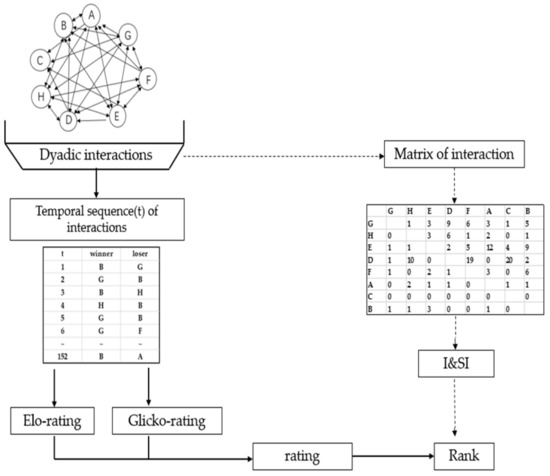
Figure 1.
Diagram highlighting the different steps required to infer dominance hierarchies. Data shown are based on 152 interactions simulated among eight individuals from pen A. The direction of the arrows indicated the direction of the attack. The outcome of dyadic agonistic interactions between individuals was recorded either in the form of a matrix or as a temporal sequence of winners and losers.
Sociometric measures, such as Landau’s index, Kendall’s index, and directional consistency index [8], have been used to study the dominance hierarchy in pigs [3,6]. However, sociometric measures are not able to capture the dynamic nature of hierarchy formation in a large social network. In recent years, dominance hierarchical indices I &SI [15], Elo-rating [16], and Glicko rating [17] have been used in rhesus macaques (Macaca mulatta) [18,19], fallow deer (Dama dama) [20], Arctic wolves (Canis lupus arctos) [21], and mice [17,22]. Before the present study, these three hierarchical indices had not been used in pigs, which are also social animals [3].
Sex is one of the most common factors that influence animal behavior [18,23]. In mice, sex affected the formation of social hierarchies [23]. Sex also influenced aggressive behavior in pigs [24]. Barrows not only initiated more aggression than females [25], but also won more fights [26]. However, the effect of sex on dominance hierarchy formation is not clear in pigs.
As a behavioral test for coping style, the backtest [27] has been used to identify pigs with more aggressive behavior. A previous study found that proactive responders for the backtest tended to be more rigid in their behavior, whereas passive responders seemed to more flexible [28,29]. No research has been conducted which has evaluated the extent to which the backtest response in pigs is associated with their dominance hierarchy.
We hypothesized that (i) the dominance hierarchies determined by I&SI, Elo rating, and Glicko rating indices were linked, (ii) these three hierarchical indices were associated with dyadic behavior traits, such as duration and frequency of active attack, being bullied, and standoff, (iii) the score of backtest could be used to predict dominance hierarchy in pigs, and (iv) the formation of dominance hierarchies would be different between gilts and barrows. The objectives of the present study were to explore the temporal dynamics of dominance hierarchy formation and maintenance in weaned pigs.
2. Materials and Methods
All procedures related to the management and care of animals in this experiment were approved by the Nanjing Agricultural University Animal Care and Use Committee (SYXK Su 2017-0007).
2.1. Animals and Housing
This experiment was conducted at Huaiyin pig breeding farm (Huaian, Jiangsu, China). All pigs were processed using standard practices during the lactation period, including teeth clipping, tail docking, and ear notching at 3 days of age, and the males were castrated at 7 days of age. Piglets were weaned at 35 days of age and moved to empty pens with their original pen-mates in a nursery room at 2 days before mixing. First, weaned pigs were blocked by sex and body weight. A total of 102 pigs (47 females and 55 barrows) from 37 litters were selected by similar body weight and mixed in 10 pens (10 or 11 females or barrows per pen) of dimension 2.5 × 2.2 m. All pens were equipped with slatted floors, stainless-steel vibratory feeders and nipple drinkers to allow ad libitum access to feed and water. All tests were conducted in the same room with natural light and dark cycle (12 h:12 h). The same animal caretaker performed all tests. At 72 h after mixing, all pigs were weighed again to calculate the average daily gain (ADG).
2.2. Backtest
At 35 days of age, all experimental piglets were subjected to the backtest twice in a separated room in the nursery barn before mixing. Piglets were placed in a supine position for one minute to observe their behavior response, and the frequency of struggling attempts was recorded [30].
2.3. Behavioral Observations
Pig behavior was recorded continuously for 72 h post mixing using a digital video recording system (Hikvision DS-2CE56C2P-IT3 3.6 mm; Hikvision network hard disk video recorder DS-7808HW-E1/M; Hikvision Digital Technology Co. Ltd., Hangzhou, China). Video cameras were installed over each pen, permitting a bird’s eye view of the whole pen. Pigs were individually spray marked (7CF, Shenzhen Zhaoxin Energy Co., Ltd., Shenzhen, China) on the back and both sides of the body before mixing. The definition of dyadic behavioral traits and the distinction between given and received behaviors are shown in Table 1. A fight had to last for 3 s. Two fights between the same pair of pigs had to be at least 8 s. Otherwise, they were treated as a single fight event [31]. The recording speed and playback speed was 30 frames/s. All video images were observed by two trained technicians. A part of behavior data was randomly selected and verified by another trained technician to ensure the correctness of the behavioral data observation.

Table 1.
Description of dyadic behavioral traits.
2.4. Statistical Analysis
I&SI values were calculated using R package ‘compete’ v.0.1 [35]. The accumulated frequencies of wins and losses of pigs were aggregated into a separate win/loss frequency sociomatrix, where the winners were listed in rows and losers in columns for each pen. A binarized 1/0 (win/loss) sociomatrix was derived from the frequency of the win/loss matrix. According to the method of a previous study [36], in each cell of the matrix, the frequency of win/loss was assigned “1” to the pigs in rows who won more often against pigs in columns, and losers in columns for each pen. If the fight was tied, both pigs received “0”. Using the binary win/loss sociomatrices, the rank orders of individuals in each pen were calculated [15] (Supplementary Materials Figure S2).
Elo rating values were calculated using R package ‘Elo rating’ [37], which reflects an individual’s success in agonistic interactions and is based on temporal sequences of decided (clear winner and loser) agonistic interactions [16]. At the beginning of the observation period, each individual in a group starts with a rating of 1000, which is updated, i.e., increased or decreased, after each agonistic interaction based on the outcome of the interaction (won or lost).
Higher-rated individual wins:
Winner Rating new = Winner Rating old + (1 − p) × k
Loser Rating new = Loser Rating old − (1 – p) × k
Lower-rated individual wins (against the expectation):
where p is the expectation of winning for the higher-rated individual, which is a function of the absolute difference in the ratings of the two interaction partners before the interaction [38] and k is a constant and determines the number of rating points that an individual gains or loses after a single encounter. The present ratings of both opponents and a determined factor, k = 100, followed a previous study [16].
Winner Rating new = Winner Rating old + p × k
Loser Rating new = Loser Rating old − p × k
Glicko ratings were calculated using ‘Player Ratings’ package v.1.0 in R [39]. The temporal changes in individual dominance ratings of each piglet in each pen were calculated using Glicko ratings index [22,40]. Glicko ratings are an extension of the Elo dynamic paired comparison models [16], whereby a cardinal dominance score for each individual is derived based on the temporal sequence of wins and losses. Briefly, all individuals begin with the same initial rating (2200) and rating deviation (300). Rating points increase or decrease for each individual determined by a function accounting for the ratings difference between opponents as well as the measure of certainty of each opponent’s rating (deviation of their ratings) [40].
Hierarchical indices I&SI, Elo rating, and Glicko ratings of pigs were calculated using R v.3.2.2 [41]. Since data of dyadic behavior traits, such as the duration and frequency of active attack, being bullied, and standoff, were non-normally distributed, logarithms of these data were used in the analyses. Partial correlations between hierarchical indices and dyadic behavior indicators were analyzed with other dyadic behavior indicators as the covariates. Multiple linear regression analyses of dyadic behavior indicators on hierarchical indices were analyzed using SPSS 25.0 (SPSS Inc., Chicago, IL, USA). The data of time (hours) to social stability of each pig after mixing were analyzed using PROC GLIMMIX procedure in SAS 9.4 (SAS Institute Inc., Cary, NC, USA). The fixed effects were sex, parity, boar, initial body weight and interaction between initial body weight and sex, and pen as a random effect. Spearman rank correlations between Glicko ratings of each hour and Glicko ratings of the last hour (72 h post mixing) were analyzed using SPSS 25.0 (SPSS Inc., Chicago, IL, USA). The results are presented as mean ± SEM and p < 0.05 was considered significant and 0.05 < p < 0.10 was considered a tendency.
3. Results
3.1. Similarity between I&SI, Elo Rating Indices, and Glicko Ratings
The dominance hierarchies of all experimental pigs were calculated by I&SI, Elo rating, and Glicko ratings indices. The win/loss frequency sociomatrices and binarized sociomatrices are shown in Supplementary Materials Figures S1 and S2, respectively. Significant correlations were found between I&SI, Elo rating, and Glicko rating indices (Figure 2, |r| I&SI and Glicko rating = 0.737, p < 0.001; |r| Elo rating and Glicko rating = 0.942, p < 0.001; |r| I&SI and Elo rating = 0.681, p < 0.001).
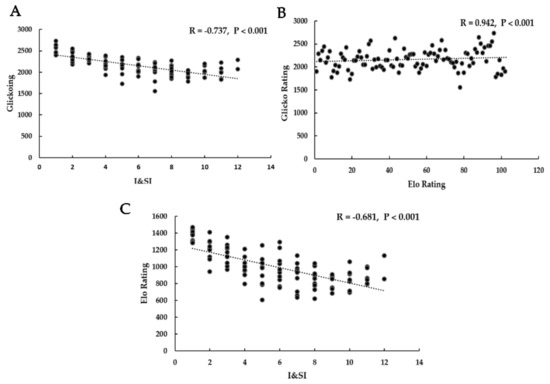
Figure 2.
Spearman rank correlations between I&SI, Elo rating, and Glicko rating indices. (A) The linear relationship between I&SI and Glicko rating; (B) The linear relationship between Elo rating and Glicko rating; (C) The linear relationship between I&SI and Elo rating.
3.2. Partial Correlation Analyses of Hierarchical Indices with Dyadic Behavioral Indicators, Backtest Score, Body Weight, and Average Daily Gain (ADG)
As shown in Figure 3A, I&SI was significantly associated with the frequency of active attack (|r| = 0.65, p < 0.05) and tended to be associated with the frequency of standoff (|r| = 0.48, p < 0.1). Elo rating and Glicko rating were associated with the duration of being bullied (|r| = 0.393~0.401, p < 0.05). In addition, Glicko rating tended to be associated with the duration of active attack and frequency of active attack (|r| = 0.416~0.439, p < 0.1). No relationships were found between hierarchical indices and duration of being bullied, backtest score, initial body weight or ADG (p > 0.1) (Figure 3B).
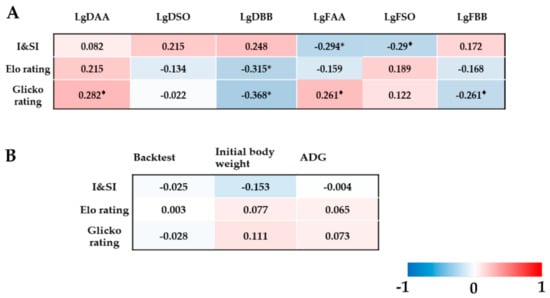
Figure 3.
(A) Partial correlation analyses between hierarchical indices (I&SI, Elo rating, or Glicko rating) and logarithms of dyadic behavioral indicators. (B) Partial correlation analyses between hierarchical indices (I&SI, Elo rating, or Glicko ratings) and backtest score, initial body weight or average daily gain (ADG). “*” represents p < 0.05. “♦” represents 0.05 < p < 0.1. Blue color represents negative correlation and red color represents positive correlation. Cells were colored on a gradient from blue (r = −1) to red (r = 1), where the colors were related to the correlation coefficients. DAA = Duration of active attack; DSO = Duration of standoff; DBB = Duration of being bullied; FAA = Frequency of active attack; FSO = Frequency of standoff; FBB = Frequency of being bullied.
3.3. Multiple Linear Regression Analyses of Logarithms of Dyadic Behavior Indicators for Hierarchical Indices
As shown in Table 2, logarithms of frequency of active attack (p = 0.050) and standoff (p = 0.053) tended to influence hierarchical index ISI. The logarithm of duration of being bullied (p = 0.035) influenced Elo rating, the logarithm of duration of being bullied (p = 0.013) influenced Glicko rating. Meanwhile, the logarithms of duration (p = 0.060) and frequency of active attack (p = 0.083) and being bullied (p = 0.083) tended to influence Glicko rating. These results are all consistent with the partial correlation analyses.

Table 2.
Regression coefficients and standard errors for multiple linear regression analyses of logarithms of dyadic behavior indicators for hierarchical indices ISI, Elo rating, and Glicko rating.
3.4. Temporal Dynamics of Individual Glicko Ratings
As shown in Figure 4, the time (hours) to achieve social stability of pigs after mixing was less for females than barrows (23.06 ± 4.15 vs. 40.55 ± 4.71 h; p < 0.001). The first ranked individual at the end of the observation time had already become the first rank individual after 10 h post mixing in all female pens and three barrow pens (pen F, G, and H). The first ranked individual in barrow pen (I) did not change after 24 h post mixing. In the barrow pen (J), the eventual dominant individual achieved the first rank 55 h post mixing (Figure 5).
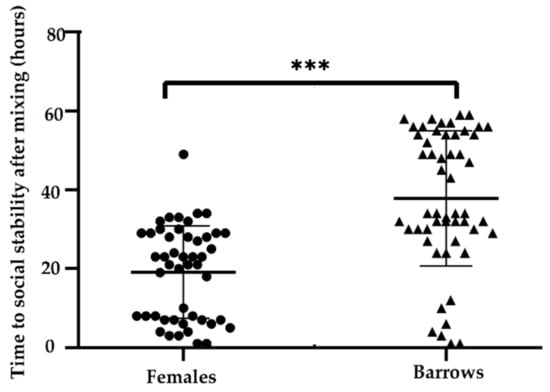
Figure 4.
The difference of time to social stability after mixing between females and barrows. “***” represents p < 0.001.
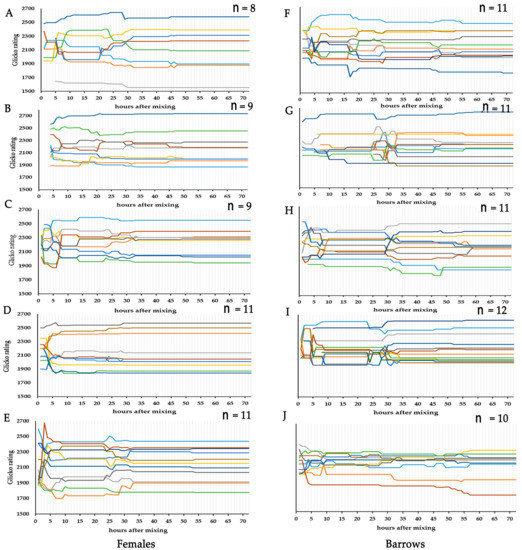
Figure 5.
Temporal dynamics of individual Glicko ratings by pen. The change in individual Glicko ratings during 72 h post mixing for all pens (A–J). Each line represents the ratings of one individual with different colors representing individual IDs in each pen. Ratings were recalculated for individuals according to their agonistic interactions and were plotted on the y-axis against hours after mixing on the x-axis. Vertical dashed lines represent the end of each hour of observations.
For the first ranked pigs, Glicko ratings of females calculated at each hour after hour 7 were positively correlated with that at 72 h post mixing (p < 0.05). Meanwhile, all Glicko ratings of barrows calculated at each hour, except hour 4 post mixing, were positively related (p < 0.05) to that at 72 h post mixing (Figure 6). This indicates that the first ranked pig in each pen quickly appeared and remained stable within a few hours after mixing.
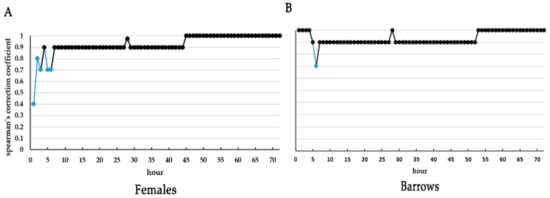
Figure 6.
Correlation coefficients between Glicko ratings at each hour and Glicko rating at 72 h post mixing for the first ranked females (A) and barrows (B). Blue colors indicate there is no correlation of Glicko ratings between the present hour and 72 h post mixing (p > 0.05); Black colors indicate there is a significant correlation of Glicko ratings between the present hour and 72 h post mixing (p < 0.05). Y-axis representing the Spearman’s ranks correlation coefficient of Glicko ratings between the present hour and 72 h post mixing.
4. Discussion
4.1. Similarity between I&SI, Elo Rating, and Glicko Rating Indices
As common approaches, dominance hierarchical indices [42] I&SI, Elo rating, and Glicko rating have been used to analyze the hierarchies of macaques [19] and mice [16,17]. In the present study, we first used I&SI, Elo rating, and Glicko rating indices to analyze the dominance hierarchies of weaned pigs after mixing. In our present study, I&SI, Elo rating, and Glicko rating indices were related to each other, suggesting that all these three dominance hierarchy indices are consistent and can be used to analyze the hierarchies of pigs in a group.
4.2. Correlation Analyses of Dominance Hierarchical Indices with Behavioral Indicators, Backtest Score, and Body Weight
In this study, the three dominance hierarchical indices: I&SI, Elo rating, and Glicko rating, were positively associated with aggressive behavior in weaned pigs post mixing, which is in agreement with a previous study [31]. Previous studies have shown that backtest score was not consistently associated with aggression in piglets [27,28,30]. In our present study, backtest scores were not related to any hierarchical indices, suggesting that the scores of backtest could not be used to predict the hierarchies of weaned pigs after mixing.
In the present study, the initial body weight and ADG of weaned pigs during the 72 h post mixing were not associated with any hierarchical indices, which is in agreement with a previous study [43]. However, ADG might be influenced by the short experimental period in our present study.
4.3. Temporal Dynamics of Individual Glicko Ratings
Glicko rating index has been used to analyze the temporal changes in the formation and maintenance of dominance hierarchies [1]. In the present study, dominance relationships were reestablished within 48 to 72 h after regrouping, which is in agreement with a previous study [8].
The time (hours) to achieve social stability of pigs after mixing was lower for females than barrows in the present study. A previous study found that barrows had a longer attack latency than that of gilts [44], which suggests that sex influences the formation of dominance hierarchies in pigs.
In the present study, Glicko ratings predicted their final Glicko ratings for the first ranked pig in each pen after 7 h post mixing. The first ranked individuals quickly appeared and remained stable within a few hours after mixing, which is consistent with a previous study [6].
Our present study provided a new insight into aggressive behavior of pigs after mixing. We found relatively precise time points when dominance hierarchies become stable in females and barrows after mixing. However, their age [45], breed [46], pen space [47], and feed could also impact the time to stabilize hierarchies. Further studies should evaluate other factors influencing the hierarchy formation. Furthermore, consideration of comparable and standardized social hierarchy indices which uncover processes of social hierarchy formation in pig production could improve animal welfare and productivity.
5. Conclusions
Consistent with our hypotheses, the three hierarchical indices: I&SI, Elo rating, and Glicko rating, were significantly associated with each other and can be used in pigs. Dominance hierarchical indices I&SI, Elo rating, and Glicko rating were partially associated with part of the dyadic behavioral indicators in weaned pigs after mixing. Contrary to our predictions, the backtest scores were not associated with hierarchical indices in weaned pigs post mixing. The time required to achieve social stability in groups of pigs after mixing was lower for females than barrows. Furthermore, the first ranked pig in each pen quickly appeared and remained stable within a few hours after mixing.
Supplementary Materials
The following are available online at https://www.mdpi.com/2076-2615/10/1/36/s1, Figure S1: Frequency Win-Loss Sociomatrices. Figure S2: Binarized Win-Loss Sociomatrices.
Author Contributions
Conceptualization, X.T., C.S. and B.Z.; Data curation, X.T., C.S., R.C. and S.G.; Formal analysis, X.T.; Funding acquisition, B.Z.; Investigation, B.Z.; Methodology, X.T. and B.Z.; Project administration, B.Z.; Software, X.T.; Supervision, C.S., R.C., X.L. and B.Z.; Writing—original draft, X.T.; Writing—review & editing, A.P.S. and B.Z. All authors have read and agreed to the published version of the manuscript.
Funding
This study was supported by the National Natural Science Foundation of China (Grant No. 31672465).
Acknowledgments
We are grateful to the Huaiyin Pig Breeding Farm for their participation, the National Natural Science Foundation of China for their support.
Conflicts of Interest
The authors declare no conflict of interest. The funders had no role in the design of the study; in the collection, analyses, or interpretation of data; in the writing of the manuscript, or in the decision to publish the results.
References
- Williamson, C.M.; Lee, W.; Curley, J.P. Temporal dynamics of social hierarchy formation and maintenance in male mice. Anim. Behav. 2016, 115, 259–272. [Google Scholar] [CrossRef]
- Sapolsky, R.M. The influence of social hierarchy on primate health. Science 2005, 308, 648–652. [Google Scholar] [CrossRef] [PubMed]
- Meese, G.B.; Ewbank, R. A note on instability of the dominance hierarchy and variations in level of aggression within groups of fattening pigs. Anim. Sci. 2010, 14, 359–362. [Google Scholar] [CrossRef]
- Svajgr, A.J.; Hays, V.W.; Cromwell, G.L.; Dutt, R.H. Effect of lactation duration on reproductive performance of sows. J. Anim. Sci. 1974, 38, 100–105. [Google Scholar] [CrossRef]
- Coutellier, L.; Arnould, C.; Boissy, A.; Orgeur, P.; Prunier, A.; Veissier, I.; Meunier-Salaun, M.C. Pig’s responses to repeated social regrouping and relocation during the growing-finishing period. Appl. Anim. Behav. Sci. 2007, 105, 102–114. [Google Scholar] [CrossRef]
- Meese, G.B.; Ewbank, R. The establishment and nature of the dominance hierarchy in the domesticated pig. Anim. Behav. 1973, 21, 326–334. [Google Scholar] [CrossRef]
- Jensen, P. Fighting between unacquainted pigs—Effects of age and of individual reaction pattern. Appl. Anim. Behav. Sci. 1994, 41, 37–52. [Google Scholar] [CrossRef]
- Fels, M.; Hartung, J.; Hoy, S. Social hierarchy formation in piglets mixed in different group compositions after weaning. Appl. Anim. Behav. Sci. 2014, 152, 17–22. [Google Scholar] [CrossRef]
- Petersen, H.V.; Vestergaard, K.; Jensen, P. Integration of Piglets into Social-Groups of Free-Ranging Domestic Pigs. Appl. Anim. Behav. Sci. 1989, 23, 223–236. [Google Scholar] [CrossRef]
- Graves, H.B.; Graves, K.L.; Sherritt, G.W. Social behavior and growth of pigs following mixing during the growing—Finishing period. Appl. Anim. Ethol. 1978, 4, 169–180. [Google Scholar] [CrossRef]
- Tan, S.S.L.; Shackleton, D.M.; Beames, R.M. The Effect of Mixing Unfamiliar Individuals on the Growth and Production of Finishing Pigs. Anim. Prod. 1991, 52, 201–206. [Google Scholar] [CrossRef]
- Lahrmann, H.P.; Oxholm, L.C.; Steinmetz, H.; Nielsen, M.B.; D’Eath, R.B. The effect of long or chopped straw on pig behaviour. Animal 2015, 9, 862–870. [Google Scholar] [CrossRef] [PubMed]
- Rhim, S.J.; Son, S.H.; Hwang, H.S.; Lee, J.K.; Hong, J.K. Effects of Mixing on the Aggressive Behavior of Commercially Housed Pigs. Asian-Australas J. Anim. Sci. 2015, 28, 1038–1043. [Google Scholar] [CrossRef] [PubMed]
- Drews, C. The Concept and Definition of Dominance in Animal Behavior. Behaviour 1993, 125, 283–313. [Google Scholar] [CrossRef]
- Schmid, V.S.; de Vries, H. Finding a dominance order most consistent with a linear hierarchy: An improved algorithm for the I&SI method. Anim. Behav. 2013, 86, 1097–1105. [Google Scholar]
- Neumann, C.; Duboscq, J.; Dubuc, C.; Ginting, A.; Irwan, A.M.; Agil, M.; Widdig, A.; Engelhardt, A. Assessing dominance hierarchies: Validation and advantages of progressive evaluation with Elo-rating. Anim. Behav. 2011, 82, 911–921. [Google Scholar] [CrossRef]
- Williamson, C.M.; Lee, W.; Romeo, R.D.; Curley, J.P. Social context-dependent relationships between mouse dominance rank and plasma hormone levels. Physiol. Behav. 2017, 171, 110–119. [Google Scholar] [CrossRef]
- Kulik, L.; Amici, F.; Langos, D.; Widdig, A. Sex Differences in the Development of Social Relationships in Rhesus Macaques (Macaca mulatta). Int. J. Primatol. 2015, 36, 353–376. [Google Scholar] [CrossRef]
- Balasubramaniam, K.N.; Berman, C.M.; De Marco, A.; Dittmar, K.; Majolo, B.; Ogawa, H.; Thierry, B.; De Vries, H. Consistency of dominance rank order: A comparison of David’s Scores with I&SI and Bayesian methods in macaques. Am. J. Primatol. 2013, 75, 959–971. [Google Scholar]
- Jennings, D.J.; Carlin, C.M.; Hayden, T.J.; Gammell, M.P. Third-party intervention behaviour during fallow deer fights: The role of dominance, age, fighting and body size. Anim. Behav. 2011, 81, 1217–1222. [Google Scholar] [CrossRef]
- Cafazzo, S.; Lazzaroni, M.; Marshall-Pescini, S. Dominance relationships in a family pack of captive arctic wolves (Canis lupus arctos): The influence of competition for food, age and sex. PeerJ 2016, 4, e2707. [Google Scholar] [CrossRef] [PubMed]
- So, N.; Franks, B.; Lim, S.; Curley, J.P. A Social Network Approach Reveals Associations between Mouse Social Dominance and Brain Gene Expression. PLoS ONE 2015, 10, e0134509. [Google Scholar] [CrossRef] [PubMed]
- van den Berg, W.E.; Lamballais, S.; Kushner, S.A. Sex-specific mechanism of social hierarchy in mice. Neuropsychopharmacology 2015, 40, 1364–1372. [Google Scholar] [CrossRef] [PubMed]
- Boyle, L.A.; Bjorklund, L. Effects of fattening boars in mixed or single sex groups and split marketing on pig welfare. Anim. Welf. 2007, 16, 259–262. [Google Scholar]
- Colson, V.; Orgeur, P.; Courboulay, V.; Dantec, S.; Foury, A.; Mormede, P. Grouping piglets by sex at weaning reduces aggressive behaviour. Appl. Anim. Behav. Sci. 2006, 97, 152–171. [Google Scholar] [CrossRef]
- Melotti, L.; Oostindjer, M.; Bolhuis, J.E.; Held, S.; Mendl, M. Coping personality type and environmental enrichment affect aggression at weaning in pigs. Appl. Anim. Behav. Sci. 2011, 133, 144–153. [Google Scholar] [CrossRef]
- Hessing, M.J.; Hagelsø, A.M.; Van Beek, J.; Wiepkema, R.; Schouten, W.; Krukow, R. Individual behavioural characteristics in pigs. Appl. Anim. Behav. Sci. 1993, 37, 285–295. [Google Scholar] [CrossRef]
- Bolhuis, E.J.; Schouten, W.G.P.; Schrama, J.W.; Wiegant, V.M. Individual coping characteristics, aggressiveness and fighting strategies in pigs. Anim. Behav. 2005, 69, 1085–1091. [Google Scholar] [CrossRef]
- Geverink, N.A.; Schouten, W.G.P.; Gort, G.; Wiegant, V.M. Individual differences in aggression and physiology in peri-pubertal breeding gilts. Appl. Anim. Behav. Sci. 2002, 77, 43–52. [Google Scholar] [CrossRef]
- Spake, J.R.; Gray, K.A.; Cassady, J.P. Relationship between backtest and coping styles in pigs. Appl. Anim. Behav. Sci. 2012, 140, 146–153. [Google Scholar] [CrossRef]
- Stukenborg, A.; Traulsen, I.; Puppe, B.; Presuhn, U.; Krieter, J. Agonistic behaviour after mixing in pigs under commercial farm conditions. Appl. Anim. Behav. Sci. 2011, 129, 28–35. [Google Scholar] [CrossRef]
- Camerlink, I.; Arnott, G.; Farish, M.; Turner, S.P. Complex contests and the influence of aggressiveness in pigs. Anim. Behav. 2016, 121, 71–78. [Google Scholar] [CrossRef]
- O’Malley, C.I.; Wurtz, K.E.; Steibel, J.P.; Bates, R.O.; Ernst, C.W.; Siegford, J.M. Relationships among aggressiveness, fearfulness and finisher pigs response to humans in finisher pigs. Appl. Anim. Behav. Sci. 2018, 205, 194–201. [Google Scholar] [CrossRef]
- Langbein, J.; Puppe, B. Analysing dominance relationships by sociometric methods—a plea for a more standardised and precise approach in farm animals. Appl. Anim. Behav. Sci. 2004, 87, 293–315. [Google Scholar] [CrossRef]
- Compete: Analyzing competitive interaction data. Available online: https://github.com/jalapic/compete (accessed on 20 December 2018).
- Appleby, M.C. The probability of linearity in hierarchies. Anim. Behav. 1983, 31, 600–608. [Google Scholar] [CrossRef]
- Animal Dominance Hierarchies by Elo Rating. Available online: https://rdrr.io/github/gobbios/EloRating/ (accessed on 20 December 2018).
- Albers, P.C.H.; De Vries, H. Elo-rating as a tool in the sequential estimation of dominance strengths. Anim. Behav. 2001, 61, 489–495. [Google Scholar] [CrossRef]
- PlayerRatings: Dynamic Updating Methods for Player Ratings Estimation. Available online: http://CRAN.R-project.org/package=PlayerRati (accessed on 20 December 2018).
- Glickman, M.E. Parameter estimation in large dynamic paired comparison experiments. J. R. Stat. Soc. Ser. C-Appl. Stat. 1999, 48, 377–394. [Google Scholar] [CrossRef]
- R: A Language and Environment for Statistical Computing. Available online: http://softlibre.unizar.es/manuales/aplicaciones/r/fullrefman.pdf (accessed on 20 December 2018).
- Sánchez-Tójar, A.; Schroeder, J.; Farine, D.R. A practical guide for inferring reliable dominance hierarchies and estimating their uncertainty. J. Anim. Ecol. 2018, 87, 594–608. [Google Scholar] [CrossRef]
- Jensen, P.; Yngvesson, J. Aggression between unacquainted pigs—sequential assessment and effects of familiarity and weight. Appl. Anim. Behav. Sci. 1998, 58, 49–61. [Google Scholar] [CrossRef]
- Weller, J.E.; Camerlink, I.; Turner, S.P.; Farish, M.; Arnott, G. Socialisation and its effect on play behaviour and aggression in the domestic pig (Sus scrofa). Sci. Rep. 2019, 9, 4180. [Google Scholar] [CrossRef]
- Erhard, H.W.; Mendl, M.; Ashley, D.D. Individual aggressiveness of pigs can be measured and used to reduce aggression after mixing. Appl. Anim. Behav. Sci. 1997, 54, 137–151. [Google Scholar] [CrossRef]
- Chu, Q.; Liang, T.; Fu, L.; Li, H.; Zhou, B. Behavioural genetic differences between Chinese and European pigs. J. Genet. 2017, 96, 707–715. [Google Scholar] [CrossRef] [PubMed]
- Spoolder, H.A.M.; Edwards, S.A.; Corning, S. Effects of group size and feeder space allowance on welfare in finishing pigs. Anim. Sci. 1999, 69, 481–489. [Google Scholar] [CrossRef]
© 2019 by the authors. Licensee MDPI, Basel, Switzerland. This article is an open access article distributed under the terms and conditions of the Creative Commons Attribution (CC BY) license (http://creativecommons.org/licenses/by/4.0/).